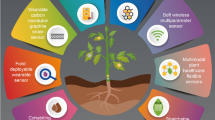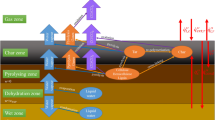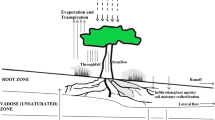Abstract
Resistance-type wood moisture meters are not reliable at moisture contents above the fibre saturation point. The aim of this study was to develop an alternative polarization-type wood moisture meter and to analyse the different calibration methods of this moisture meter in comparison with the traditional resistance-type wood moisture meter calibration method. A significant decrease (up to 3.5% of moisture content) in the tolerance interval of a single measurement was attained by introducing and integrating the original electrical wood charging number into the calibration model of the novel wood moisture meter with electric polarization effect for a high wood moisture content (MC) above 100%. The tolerance interval convergence was analysed using the traditional method of increasing the number of measurements and averaging the results and was compared to the novel method of compensating for random deviations, as used in this study. To calibrate the wood moisture meter, the wood’s electrical resistance and electrical capacitance timelines during the electrical charging cycle were registered in real time (online) with a preselected measuring speed and saved to the microcomputer memory. When the measurements were completed, the measurement data was processed by the device’s microcomputer. This novel polarization-type moisture meter allows for the moisture content of specific tree species to be predicted by selecting a suitable calibration model from a set of eight. The novel wood moisture meter can be used to monitor wood drying and to determine seasonal variations in the moisture content of growing trees.














Similar content being viewed by others
References
ASTM D4444–08 (2008) Standard test method for laboratory standardization and calibration of hand-held moisture meters. Annual Book of ASTM Standards. ASTM International, West Conshohocken, p 10
Bes Bollmann® Drying and Control Systems. https://www.bes-bollmann.com/. Accessed 3 Mar 2020
Berga SC, Gil RG, Anton AEN, Mun͂oz AR (2019) Novel wood resistance measurement method reducing the initial transient instabilities arising in DC methods due to polarization effects. Electronics 8:1253
Brookhuis (2009) Moisture measuring manual version 1.4, 27. Brookhuis Micro-Electronics BV
Eco Chemie (2019a) Metrohm Autolab B. V. http://www.ecochemie.nl. Accessed 13 Apr 2019
Eco Chemie (2019b) Metrohm Autolab B. V. https://www.metrohm.com/en/applications/ Accessed 13 Apr 2019
EDG (2010). Dried Timber- how to specify correctly. In: Welling J (ed), European Drying Group (EDG) and COST E53 2010, pp 38
Edwards NC (1974) Procedure for the determination of species correction data for electrical resistance type moisture meters. CSIRO Div. Forest Products. (Unpublished divisional report), p 10
Forsén H, Tarvainen V (2000) Accuracy and functionality of hand held wood moisture content meters. VTT publications, vol 420, p 102. http://www.vtt.fi/inf/pdf/publications/2000/P420.pdf. Accessed 13 Apr 2019
Gann Mess-u Regeltechnik GmbH. http://www.gann.de. Accessed 13 Apr 2019
Gao S, Bao Z, Wang L, Yue X (2018) Comparison of voltammetry and digital bridge methods for electrical resistance measurements in wood. Comput Electron Agric 145:161–168
https://www.mdpi.com/2079-9292/8/11/1253/htm. Accessed 3 Mar 2020
ISO 3130:1975 (1975) Wood—determination of moisture content for physical and mechanical tests. International Organization for Standardization, Switzerland, p 2
ISO 3534–1:1993 (1993) Statistics—vocabulary and symbols—part 1: probability and general statistical terms. International Organization of Standardization, Geneva, p 46
ISO/EIC (2008) GUIDE 98-3:2008(E) uncertainty of measurement—part 3: guide to the expression of uncertainty in measurement (GUM:1995). International Organisation for Standardization, Geneva, p 120
James WL (1993) Fundamentals of hand held moisture meters: proceedings. ASTM hand held moisture meter workshop, Madison, WJ, Forest Product Society, 5 May 1993, pp 13–16
Keithley (2004) Low level measurements handbook 6th edition, p. 239. http://web.mit.edu/8.13/8.13d/manuals/LowLevMsHandbk.pdf. Accessed 3 Mar 2020
Kiviste A (1999) Matemaatiline statistika MS excel keskkonnas (Mathematical statistics in MS excel environments). GT tarkvara OÜ, Tallinn, p 86
Laaneots R, Mathiesen O (2006) An introduction to metrology. TUT Press, Tallinn, p 271
MatLab™ (MathWorks, Natic, MA). URL https://se.mathworks.com/products/matlab.html. Accessed 03/03/2020.
NdtJames (2020) http://www.coste53.net/downloads/Edinburgh/Edinburgh-Presentation/72.pdf. Accessed 13 Apr 2019.
Romann T, Oll O, Pikma P, Tamme H, Lust E (2014) Surface chemistry of carbon electrodes in 1-ethyl-3-methylimidazolium tetrafluoroborate ionic liquid: an in situ infrared study. Electrochim Acta 125:183–190
Rozema P (2010). Dos and don’ts in respect to moisture measurement. The future of quality control for wood & wood products, 4–7th May 2010, Edinburgh. The Final Conference of COST Action E 53: 9.
Sachs L (1982) Applied statistics: a handbook of technigues. Springer-Verlag, New York, p 734
Scanntronik Mugrauer GmbH (2019). https://www.scanntronik.de/. Accessed 13 Apr 2019
Skaar C (1964) Some factors involved in the electrical determination of moisture gradients in wood. For Prod J 14(6):239–244
Stamm AJ (1927) The electrical resistance of wood as a measure of its moisture content. Ind Eng Chem 19(9): 1021–1025. https://doi.org/10.1021/ie50213a022. Accessed 13 Apr 2019
Tamme V, Muiste P, Mitt R, Tamme H (2011) Determination of effective diffusion coefficient and mechanical stress of pine wood during convective drying. Balt For 17:110–117
Tamme V, Muiste P, Tamme H (2013) Experimental study of resistance type wood moisture sensors for monitoring wood drying process above fibre saturation point. For Stud 59:28–44
Tamme V, Muiste P, Padari A, Tamme H (2014) Modelling of resistance-type wood moisture meters for three deciduous tree species (black alder, birch, aspen) in moisture contents above fibre saturation point. Balt For 20(1):157–166
Tamme V (2016). Development of resistance-type control methods for wood drying. Ph.D. Thesis, Estonian University of Life Sciences
Tamme V, Tamme H, Bernotas T, Muiste P, Olt J (2020) Moisture meter and method for measuring the moisture content of wood above the fibre saturation point of a wood with the electric charging effect. Patent No EE 05822B1 Priority: 16. 07. 2018. https://ee.espacenet.com/publicationDetails/biblio?DB=EPODOC&II=0&ND=3&adjacent=true&locale=ee_EE&FT=D&date=20200217&CC=EE&NR=201800017A&KC=A Accessed 3 Mar 2020
Tiitta M, Savolainen T, Olkonen H, Kanko T (1999) Wood moisture gradient analysis by electrical impedance spectroscopy. Holzforschung 53:68–76
Vermaas HF (2002). State of the Art and Latest Technological Advances in the Drying of Fast-Grown Eucalyptus. In: Proceedings of 4th COST E 15 workshop, “methods for improving drying quality of wood”. Santiago de Compostela, Spain, 2002, 17
Zelinka SL, Stone DS, Rammer DL (2007) Equivalent circuit modelling of wood at 12% moisture content. Wood Fiber Sci 39(4):556–565
Acknowledgements
This work was partially supported by institutional research funding IUT20-57 of the Estonian Ministry of Education and Research.
Author information
Authors and Affiliations
Corresponding author
Ethics declarations
Conflict of interest
On behalf of all authors, the corresponding author states that there is no conflict of interest.
Additional information
Publisher's Note
Springer Nature remains neutral with regard to jurisdictional claims in published maps and institutional affiliations.
Rights and permissions
About this article
Cite this article
Tamme, V., Tamme, H., Miidla, P. et al. Novel polarization-type moisture meter for determining moisture content of wood above fibre saturation point. Eur. J. Wood Prod. 79, 1577–1587 (2021). https://doi.org/10.1007/s00107-021-01682-6
Received:
Accepted:
Published:
Issue Date:
DOI: https://doi.org/10.1007/s00107-021-01682-6




